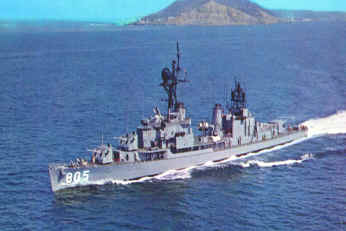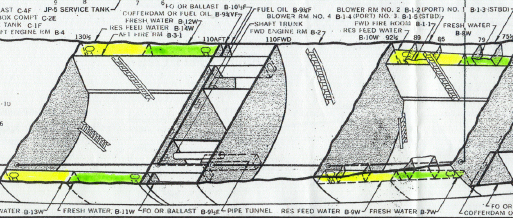|

Enter the Water King
By Richard H. King, CDR USNR-Ret.
At the time of this story, CDR King was LT JG, Main Propulsion
Assistant (1965-1968),
(Assistant Engineering Officer for Main Propulsion)
U.S.S. CHEVALIER (DD-805)
 Water on a Sumner/Gearing was an item that had every
engineering officer, assistant engineering officer and engineering chief focused
on at least six times a day. It was a very high priority item. There
were eight water tanks, four for feed water and four for potable (drinkable)
water. Gearings that could make water in sufficient quantities were the
"stars".
Water on a Sumner/Gearing was an item that had every
engineering officer, assistant engineering officer and engineering chief focused
on at least six times a day. It was a very high priority item. There
were eight water tanks, four for feed water and four for potable (drinkable)
water. Gearings that could make water in sufficient quantities were the
"stars".
On many Gearings, water hours
(restrictions) were common. Master Chief Don Hackbarth of the USS
CHEVALIER DD-805 was truly entitled to be called "Master Chief"
because of his management skills in running the two evaporators (forward and
aft) that were two different sizes. Because of the shape of the ship, the
forward evaporator was almost twice as big as the after one, but unless
both were working perfect, the ship could get in trouble in no time. They
both had to be very high priority items to be maintained and kept working
perfect, at full design capacity. It is true that the standards for
"feed water" and "potable" water were very different.
Feed water could be contaminated with
bacteria and the boilers didn't give a damn. No problem.
On the other hand, potable water could be contaminated with minerals and the
sailors didn't give a damn. So what I reveal next is really Master Chief
Don Hackbarth's strategy (other than to keep both evaporators working
perfectly). First thing you need is a "Water King",
the counterpart of the "Oil King". He was
in charge of water and had to be the very best! He would be a MM2 however
rather than a BT2. At sea, the evaporators would fill small tanks, perhaps 100
gallons or less, that were tested both electronically and chemically for
impurities. If there were too many "minerals" (including
salt) the water could be sent to "potable". It was probably good
for the crew and lowered their sex drive maybe. Sort of like saltpeter
which by the way was never added to the crew's food (Navy Urban Myth). On
the other hand, if a batch of water enroute to potable tanks had too much
bacteria, it would not be caught until later, by the ship's corpsman, when he
checked daily samples. to be the very best! He would be a MM2 however
rather than a BT2. At sea, the evaporators would fill small tanks, perhaps 100
gallons or less, that were tested both electronically and chemically for
impurities. If there were too many "minerals" (including
salt) the water could be sent to "potable". It was probably good
for the crew and lowered their sex drive maybe. Sort of like saltpeter
which by the way was never added to the crew's food (Navy Urban Myth). On
the other hand, if a batch of water enroute to potable tanks had too much
bacteria, it would not be caught until later, by the ship's corpsman, when he
checked daily samples.
A sample of the four potable tanks were delivered by the water
king to the lead corpsman daily and if the bacteria count was high, the
corpsman would prescribe chemicals which the water king would then add to the
water. So here are the questions. Can you make water in a polluted
port? Yes, but make boiler feed water. The boilers don't care.
What if you get a bad batch of feed water in a polluted port? Pump
it over the side and start a new batch. Master Chief Hackbarth
liked to leave port at what I call 100%; 100%, meaning topped off on both feed
and potable. We often lit off the plant early so he could achieve
that goal. In many ports we could get potable water from the pier and in
some ports we could get feed. This leads to the climax of this story.
 AS seen at left, The water tanks on a Sumner-Gearing destroyer were located
along the outboard sides of the lower levels of the boiler rooms. The
"yellow area" is the reserve feed water and the "green area"
is the fresh water storage.
AS seen at left, The water tanks on a Sumner-Gearing destroyer were located
along the outboard sides of the lower levels of the boiler rooms. The
"yellow area" is the reserve feed water and the "green area"
is the fresh water storage.
Chevalier never had "water
hours" in the four years I was on board. But we went beyond
that. I think it was January 1968 and we pulled into Manila PI for R&R
(rest and relaxation). Soon an American diesel sub tied up next to us. The
line had barely been put over and I was being asked for water. There was
neither potable nor feed quality water available at the pier in Manila. My Chief
Engineer was one of the first over the brow so the decision was mine. I
listened to their stories of woe, they hadn't had a shower in weeks.
"How much do you need"? Their request was fairly modest. They
needed both "potable" water for some showers, but they also needed
"Battery Water".
"Battery Water" and "Feed
Water" are almost the same. I am a reserve O-2 on a Navy ship
and I get to decide this issue? Captain, XO and CHENG (Chief Engineer) are
long gone. I said OK, we are one Navy, we have water and you don't so I
will give you some. Master Chief Hackbarth was having conniptions. But
I made my decision, we will give the sub a lot of water. Then they kind of
insulted me by sending over a team of three to test our "feed water" to
see if it was good enough for their damn batteries. (It was).

 

|
